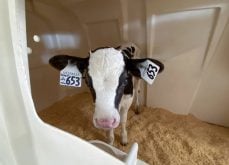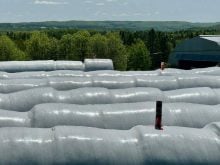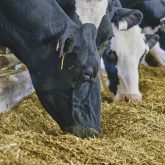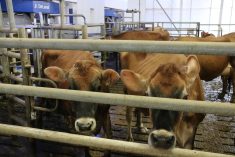Ontario dairy farmers who made the trip to Germany for EuroTier and on-farm visits this past November didn’t just return with photos and brochures — they brought back a deeper understanding of what’s possible.
The group, made up of 56 farmers from more than 40 families, visited leading European dairy operations and toured EuroTier, the world’s largest trade fair for livestock professionals. The tour was hosted by the Progressive Dairy Operators organization.
While many went in with a healthy skepticism they returned with fresh perspectives and practical insights. For those who couldn’t attend, their takeaways offer a valuable peek into the future of feeding, regulation and resilience in dairy farming.
Precision feeding with less labour
For years, automatic feeding systems were considered best suited to small- or medium-sized operations. But visits to several progressive farms in Germany challenged that assumption.
“Some of our guys milk 400 or 500 cows, and they wouldn’t have considered robotic feeding before this trip,” said Jack Rodenburg, a dairy consultant who organized and led the group. “But they’re looking at it differently now.”
At the heart of the shift were systems like the Triomatic WP and T30 bunker, developed by Trioliet, a Dutch company specializing in automated feeding. The Triomatic system consists of two main parts: the WP robot, which mixes and distributes feed, and the T30 bunker, also referred to as a ‘feed kitchen’. Farmers load the bunkers with ingredients every two days, and the robot handles the rest—batching precision rations for different cow groups and distributing them automatically.
“The robot gets its instructions based on pre-programmed feed recipes,” said Bente Meulenkamp, marketing and communications specialist for Trioliet. “One group might get more corn silage, another more hay. The farmer can adjust rations any time through an app or on a touchscreen.”
Farmers can choose between rail-powered or battery-powered models, depending on barn layout and flexibility. While rail systems provide a constant energy source and are well suited for fixed infrastructure, battery-powered versions offer more adaptability, charging between feedings at their docking station.
Trioliet recently introduced a larger version—the WP 600—built for farms with 600 to 800 livestock units. It offers a six-cubic-metre capacity, double that of the standard model. Due to battery limitations, it’s currently rail-powered only.
“We’re starting to conclude very quickly that bringing that precision is a good thing,” said Rodenburg. “Whether or not the delivery system is a small robot or a traditional mixer, the batching accuracy of these systems has clear advantages.”
The cost-benefit of automation
Nick Groot, a retired farmer from Ingersoll and a member of the trip’s travel committee, agrees that automated feeding is less about novelty and more about addressing real challenges.
“The automation is more a result of the labour problems,” he said. “That’s a problem everywhere.”
Groot, who spent much of his career with Dairy Herd Improvement (DHI), said efficiency and sustainability often go hand-in-hand.
“The more efficient you are, the less harmful you are to the environment,” he said. “And that’s the best you can do.”
According to Rodenburg, higher-yielding cows produce less methane per litre of milk. Similarly, heifers that freshen at 19 months instead of 24, produce lower emissions before they reach the milking line. These strategies aren’t just environmentally sound, they’re also profitable.
Regulation by example
Beyond automation, Ontario farmers paid close attention to regulatory conditions in Europe, many of which they believe could foreshadow changes in Canada.
“You see things here that may trickle down to us in 10 years,” said Rodenburg. “We came here to learn about sustainability and the issues around carbon footprint, methane, and consumer expectations.”
One detail that stood out during the trip was that some German farms using robotic milking systems still provide one free stall per cow.
“Is it necessary? Probably not,” said Rodenburg. “But to the consumer, it makes sense. And that perception matters.”
European governments often support producers with subsidies when regulations impose financial burdens – something Ontario farmers can’t always count on.
“Here, if the government forces a change, [farmers] usually pay for it,” said Rodenburg. “That’s not something Canadian farmers can rely on.”
Groot observed that some German farmers make the most of government incentives in creative ways.
“One farm we visited had its productive land focused on high-quality forage,” he said. “But on less-productive land, they shifted to protecting nesting bird species to maximize government payments. Maybe we need to get better at that kind of thing.”
Efficiency is the new sustainability
For Ontario farmers, the clearest message from their European counterparts was that sustainability doesn’t always mean sacrifice, it often means better business.
“We think a lot of the solutions to lowering emissions come down to increased efficiency,” said Groot. “That’s the innovation you see in Europe, they’re always trying to make things better, easier and with a lower carbon footprint.”
Even without a structured climate action plan, many of the technologies showcased at EuroTier, automated mixers, feed management apps, sensor-driven bunkers. are driving environmental benefits simply by cutting waste and optimizing inputs.
Bringing it home
Some of the most impactful lessons didn’t come from the show floor, but from the seats on the bus.
“Farmers learn much better from one another than from experts,” said Rodenburg. “That mentoring and shared experience, the knowledge that someone else is facing the same challenges, is what makes a trip like this valuable.”
Groot is already thinking about how to apply what he saw to a new entrant farmer taking over his barn.
“I’ve got ideas now about what equipment to invest in and where the payoffs really are,” he said.















